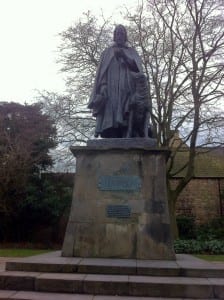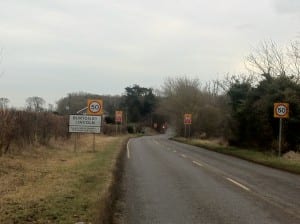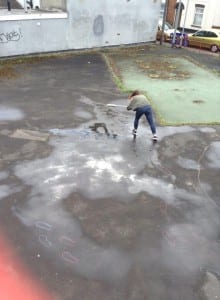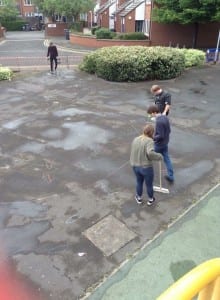Framing Statement
For our site specific performance we have been told to use the resource of audio. This may be in the form of speakers, headphones or both, whatever we feel will speak to us on our ‘wander’ or ‘drift’. Karen has spoken to us about both these forms of movement throughout an area, preferably one we haven’t visited or been to before.
Drift ‘a continuous slow movement from one place to another’ (Oxford, 2015) Karen told us that a drift allowed us to move through the city at a pace of our own and follow paths and roads to places we hadn’t been before. To drift through Lincoln in our groups and have an epiphany on what we could achieve and where we would like our site specific performance to be based.
Whilst different people began their drifts on foot I chose a different method, I would use my bicycle to move from place to place. This, I felt would help me understand the meaning of time within a drift, as I would literally be drifting by places without fully taking in what was around me at that specific moment in time. Thus allowing me to stop and take pictures of things that intrigued me and I found interesting, therefore making my ‘drift’ more personal to me, whilst still conforming to the hour time limit Karen had imposed on us to allow us to get the most out of our experience and not travel to far out of Lincoln.
These are just some of the pictures I took whilst out on my bike,
(Davies, 2015) fig.1
(Davies, 2015) fig.2
The pictures you see above are the places and objects I found most interesting whilst on my ‘drift’. For me, they both relate to time and the speed at which time passes. For example, the later photo is an image of a B road into Lincoln that goes from a 60pmh speed limit to a 50pmh speed limit as you can see. Whilst approaching this area as I often do, you can see ahead for quite a while, therefore changing the speed limit by 10pmh, seems to be unclear to me. This is what correlated between this image and my thoughts of the ‘drift’. As the drift was a voyage of ambiguity, a point in which travelling became unclear and the recent past seemed quite distant. The drift highlighted to me that, although we have restrictions on speed and time, we all travel at the same speed and although not necessarily at the same time.
Speed is controlled by the forces around us, as is time, but time changes from places to place. For example, Australia are nine hours in-front of Britain, but Albania are eight hours behind. This gave me a starting block for what I wanted to achieve from the drift and what I wanted to achieve for my site performance.
The first image you see above is of Tennyson, for me it wasn’t about his importance to society, it was more about the effectiveness of the statue. As I sat across from the statue on an old weathered rickety bench, I noticed that it had aged itself within time. There were parts that were rough and faded due to the conditions it had been in for the 113years it had been stood there. Nonetheless, it had been stood there for over a century, I then realised that I wouldn’t fair to well if I had been stood there for that long. I therefore set out so that I would use the stimuli of time and time passing, when I joined a group later in the course.
Analysis of Process
Now I have joined a group, there are 5 of us, Emily, Anna, Kyle, Nick and me. For our first group task, Karen has asked us to take a recorder off of Richard (The sound expert) and record different sounds in different areas to get used to live audio recording and understand the difficulties that arise whilst recording in even the quietest of rooms. We first recorded each other speaking at different pitches and different volumes. The problem we found with this specific activity, was that you had to make sure that your mouth was within the right distance of the microphone, as it wouldn’t otherwise pick up the full quality of your voice.
We secondly tried to record a few notes on a piano, to help distinguish between different notes and see whether the full quality of the recording was highlighted in the playback. A problem we found with this was, although the recording distance seemed adequate, the distortion we experienced in the playback was quite unfathomable, as we couldn’t understand what could have caused it.
However, after extensive research in recording we found out that it may be due to the recorder and the transference of analogue to digital sound waves. Therefore if we needed to record sound in the form of music or instruments we ruled out the recorder as we deemed it inadequate to record high quality sound. Thankfully we could still use music as a resource in our performance, as Nick had a high quality microphone for recording.
The final hurdle we encountered when choosing a recorder and the recording process we would use was, wind. Not matter how we covered the microphone, the blowing gales would interfere massively with the sound. We used a variant amount of wind socks to try and muffle out the sound and get a deeper and clearer sound. However, we didn’t find these apparatuses useful, as they left our recorded material with a quieter sound, a distorted vibrato due to the sock and a, what can only be described as, ripping sound due to the texture of the sock. At one point in the recording process, we even stood around the recorder with all our coats open, shielding it from the wind, hoping it would create a clearer sound. Much to our dismay, this attempt didn’t work either, however we had realised that, to record a clearer sound we would have to record in a near silent room, as recording outside would be just too unequal and would ruin our end product.
The Final Route
After last week, of testing the recorders and using different recording equipment, Karen had told us to go on a ‘wander’ or ‘drift’ as a group. This journey would help us discover what we wanted to portray in our performance and would hopefully find the place in which we would perform our site specific piece. We set off on a dressily morning, we didn’t know where we were going and we didn’t know where we’d end up, the only thing dictating our final destination was a simple left or right and the time we had been allocated. As before, we had been allocated about an hour to find a natural end to our wander. We set off into town, walked past the old architecture and over the canal, through the Stone Bow once or twice, past the train station and over the flyover. Once in the middle of the flyover we turned around to face the city. We could almost see where we had come from and the path we had taken to get the where we were. We looked up at the church in the centre of town and then further up again to the magnificent cathedral. We then turned back around and continued on our voyage, finally ending up at the furthest end of the flyover, we found a park. One that hadn’t been taken care of at all, it had graffiti throughout the walls, fences and equipment, of which there was only a slide, the rest had been ripped up and moved.
We found this park quite astonishing, the fact that it was still there amused us. With just a slide to the left and patches where other recreational equipment and structures would have stood. The resonance of the missing and apparent abandonment of this place was projected all over, as if people had forgotten it ever existed as a park. From what we could see, it had only been used as a walk through for local residents.
A stimulus I engaged with when we first found our Site, was Brecht’ theory on ‘Epic Theatre and the ‘Street Scene’. The relations between site specific work and Epic theatre is that of
‘Eschewing the usual depiction of human action as psychology driven to show instead causes of a social, historical and political kind; thus representing the individual less as the agent of events than the focus of external forces.’ (Counsell, Wolf & Wolf, 2001, 43).
This I feel fuelled my interest with my groups Site area, as it made me think not just of what we could create within our site but, what has been there before ‘the park’ and what will become of the place in time?
This spurred us forward to create a piece in which time was always relevant and people, be them participants or not who interacted with our performance, would themselves be entering our space and at our time and stepping back from the contextual form of society and reality to participate in creating a format of time that showed the past, present and future. However, it has to be remembered that
‘To compare life to a movie is not to say, as the cliché has it, that life imitates art, though surely there is truth in that. Nor is it to say that life has devised its own artistic methods and thus reversed the process – art imitates life – though that also is true.’ (Bial, 2004)
The quote above shows my only qualms about our site specific piece, as I don’t want our performance to be seen as a performance, as we won’t be acting. I want our piece to be seen more as a piece of live art.
Debating Changes
When we had finally chose an area we all liked (the park) and had chosen our main stimuli (time/time passing) we decided to have a discussion about the key features we would include within our audio. We decided that we would include part of a You Tube clip that had a gentleman speaking about Lincoln in 1935 and what it was like. The clip did have a video accompanied to it but at this point in the process, we weren’t using a visual stimulus, just an audio one. The short video is called ‘The City of Lincoln (1935) and is available at: https://www.youtube.com/watch?v=fNKuYdFAuAY (You Tube, 2014)
We thought this video would help us project the audible image we wanted to portray, as he spoke about specific places in Lincoln, which we would walk past on our ‘drift’. We thus thought this would show our audience/participants what Lincoln was like then and how it had changed. Showing the significance of what happens through time and how people don’t notice it happening until it has happened. This, we felt would be shown particularly well, as our participants would probably not have been around in 1935 to remember what it would have looked like. Therefore having the stimuli of audio we could allow them to hear what was being described, whilst they had the chance to look for themselves how it looked now.
Photography is the science, art and practice of creating durable images by recording light or other electromagnetic radiation, either electronically by means of an image sensor, or chemically by means of a light-sensitive material such as photographic film. Therefore, my group’s ideas of how we can relate our experience to our audience have changed. Instead of taking our audience/participants on a tour of Lincoln, through audio only, we have decided to ingratiate in the use of a visual stimuli. This idea came to us when I recorded our wander ‘destination map’ on my GoPro, in order to add the audio over the top, so we could asses where we were in relation to the audio script and in reality.
When reviewing the footage with Karen, she directed us towards the notion of a multi-media experience, in which our audience listen to our vocal information/guidance, whilst viewing what we saw whilst on our own tour. This type of media integrated work reminded us of the performance format for ‘Uncle Roy’, by Blast Theory.
This work by blast theory involves participants buying tickets to become part of the game. They sit in an office area on a computer playing virtually and wandering around the city. The initiators of this ‘performance’ then walk around the city with a walkie-talkie and a hand held computer, on which they can see the virtual representatives in real time. Their objective is to find as many people as they can, once found, the participants are ‘out of the game’. Obviously, our site specific work wouldn’t become a game, by in which we try and find our participants, but one in which our participants can see what was happening and what it was like when we partook on our destination specific walk.
we thus thought that taking our participants on the destination ‘tour’ with us virtually would help them understand their surroundings as we did and hopefully let them see what has changed in the time between our tour and theirs. As
‘The city is an arena where the unfamiliar flourishes, where the disjointed and the disrupted are constantly threatening to overwhelm us. It is also a zone of possibility; new encounters.’ (http://www.blasttheory.co.uk/)
Whilst our participants are on our ‘tour’ they will experience the sights we saw whilst hearing the group and I talk them through the area, its past, present and the ever near future, the tour to our site will also help our audience understand our stimuli as they will be guided to places which have significance to our site, these areas will become apparent once on the tour and the site is completed.
As, when the participants of our site specific performance join us on our ‘voyage’ they will be undertaking in a part of history themselves. They will experience that the things we do today, in the here and now, reflect towards the future and resonate in the past. Our ‘journey’ along with theirs, will consist of theories about ‘Life=Art’ (Berghaus, 2010, 128). This being that everything we do in life can be constrained down to a single art from, for example, breathing can be seen to be an art as it is so delicate and is ‘performed’ differently be each and every one of us, however together, we all par-take in it. Thus showing that life can be seen as one live performance, for Shakespeare does say
‘All the world’s a stage and all the men and women merely players, they have their exits and their entrances’ (Shakespeare, 1970). Therefore, who are we to say life cannot be a performance, even when we enter and exit? Gunter Berghaus speaks of a ‘reconstructed universe’ (Berghaus, 2010, 128) the idea of a ‘reconstructed universe’ (ibid, 128). We hope to portray this idea to our participants, as our tour features historical content but it allows each audience member to question what happens and will happen in life. We show them that life is a simple building block that is constantly being removed, re-sculptured, re-imagined and then replaced. Each generation creating a newer reality in which we refocus our ideas for our time and the times to come. Audience’s members will become the generational builders for moments when we, as a group will give them insight into what happens after we are gone and what will continue to happen in order to build a ‘stronger’ society.
Performance Evaluation
Our performance was at 2pm on the 7th of May and all day it had been raining. When myself and Anna entered the LPAC to wait for the arrival of Conan and Karen we had a dilemma. Start the performance inside and not get the full effect of taking the tour with us, or go out with the I pad’s and risk getting them wet. Luckily as we embarked on our drift the rain stopped and the sun started to show. We set off from the same place as the video shows but, on a different day and at a different time. The video had been shot a few weeks prior but still followed the same route the participants would take. We hoped this would show that we may all be at the same speed but not necessarily the same time, we hoped that the participant would understand this fact and see that a differentiation in instant didn’t mean a differentiation in speed.
Our performance took place on a damp park floor but, it was of no concern to us, as the chalks we were using to draw were perfectly capable of drawing over water. We draw imaginary objects and apparatus which could have been in the park, the idea was to draw something that resembled the significance of absence. Thus I chose to draw out a roundabout with children playing on it, I later washed this away, to show the resemblance that time keeps moving forward but, what we bring with us is our choice. This symbolised that through life we build things for our generation and the generations to come, but whether we edit it and keep it for others is our choice. Throughout our performance we remained silent, even as tour guides, myself and Anna didn’t speak. We hoped this would signify the fact that silence is like a change in a force through time, you don’t notice it until it is fully happening or has happened, much like the ending or beginning of a song.
Conan used the word, simulacra, to describe our piece. I feel this translates our piece very well as, our performance contained images that had a resemblance to what was occurring, but at the same time it had a very unreal semblance about it.
Here above you can see the act of creating a resemblance of what was before, but at the same time washing away those creations and memories to create and recreate a different scene that we felt should be there at that specific time. Looking back, I would only change one element of our piece. This being the equipment we used, as the in-ear headphones were of little use within the city and near traffic. If I had a chance to re-do or recreate this piece, I would definitely use over-ear headphones, to help create a better atmosphere and a better quality of sound for our participants.
Bibliography
Oxford. (2015) Pocket Oxford Dictionary. Oxford: University Press.
Counsell, C et al. (2001) Performance Analysis: An introductory Course book. 1st end. United Kingdom: Taylor & Francis.
Bail, H. (2004) The Performance Studies Reader. 2nd end. New York: Taylor & Francis.
You Tube (2014) City of Lincoln (1935). [Online] Lincolnshire: You Tube. Available from: https://www.youtube.com/watch?v=fNKuYdFAuAY
http://www.blasttheory.co.uk/projects/uncle-roy-all-around-you/
Berghaus, G. (2010) Theatre, Performance and the Historical Avant- Garde. Basingstoke: Palgrave Macmillan.
Shakespeare, W. (1970) As You Like It. (Shakespeare, Signet Classic). United States: Signet Classics.
Davies, D. (2015) Site Specific: Drift work and Analysis (figure/s: 1, 2, 3, 4, and 5)




